Here you’ll find information to help you live more successfully with hemophilia. From staying active and healthy to managing bleeds, it’s all easier when you know what to do and are prepared to do it.
Tips to help you navigate your hemophilia journey.
Tips to help you navigate your hemophilia journey.
Here you’ll find information to help you live more successfully with hemophilia. From staying active and healthy to managing bleeds, it’s all easier when you know what to do and are prepared to do it.
Participating in sports and exercise: Safety first!
Participating in sports and exercise: Safety first!
People living with hemophilia can exercise and participate in sports—and it’s important to do so safely. Work with your health care provider to create a fitness plan that’s right for you.
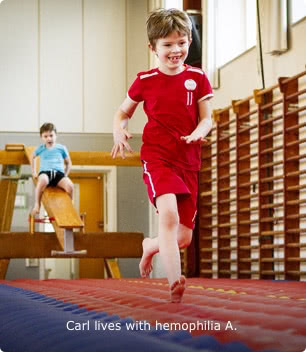
Activities for kids, teens, and adults.
Activities for kids, teens, and adults.
Be sure to talk with your or your child’s doctor about which activities they recommend. Here are some typical activities that people with hemophilia often participate in.
Children
Walking to school
Family bike rides
Dance classes
Swim lessons
Teens
Bowling
Swimming
Cycling
Dancing
Archery
Fishing
Golf
Strength exercises (weight-bearing)
Adults
Walking
Swimming
Yoga
Pilates
Cycling
Strength exercises (weight-bearing)
Dancing
Bowling

People living with hemophilia shouldn’t exercise or play sports.

Exercise is important for people with hemophilia because it strengthens muscles, which helps protect joints, and reduces the risk of being overweight, which places added stress on joints.

People living with hemophilia shouldn’t exercise or play sports.


Exercise is important for people with hemophilia because it strengthens muscles, which helps protect joints, and reduces the risk of being overweight, which places added stress on joints.
Sports, exercise, and risk.
Sports, exercise, and risk.
Every sport or exercise has a certain amount of risk—but some, such as those that involve physical contact with other players or equipment, may be unsafe for people living with a bleeding disorder. When you know the level of risk associated with different activities, you’ll be better prepared to make good choices. Always discuss your plans with your doctor before engaging in any physical activity.
Examples of physical activity ratings.
These are not recommendations. The ratings are intended for informational purposes only.
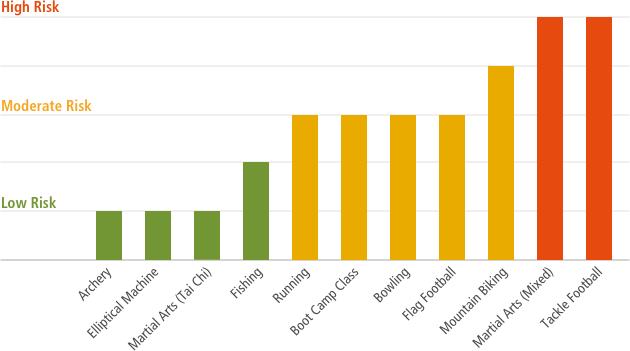
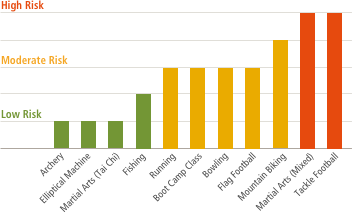

Talk to the coach. If your child is involved in team activities, meet with their coaches, the school nurse, and the athletic trainer to set up an action plan in case they are injured or experience a bleed.

Talk to the coach. If your child is involved in team activities, meet with their coaches, the school nurse, and the athletic trainer to set up an action plan in case they are injured or experience a bleed.
Choosing an activity you’ll enjoy.
Before starting a new sport or exercise, it’s a good idea to discuss any pros and cons with your doctor. Be ready to answer a few questions, such as:
What are your fitness goals?
What is your current level of fitness?
Which activities are you interested in?
Do you have any joint damage from bleeds or any mobility issues that would affect your participation?
Have you considered working with a trainer or physical therapist to prepare for this activity?
Are you aware of the benefits and any risks of this activity?
HEMOPHILIA FACT
Exercise can be fun! Find an activity you enjoy doing. Make it even better by asking a friend or family member to join you.

HEMOPHILIA FACT
Exercise can be fun! Find an activity you enjoy doing. Make it even better by asking a friend or family member to join you.

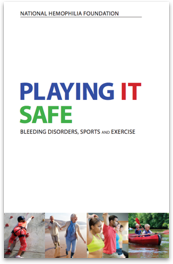
Playing it Safe: A guide to physical activities.
Learn more about the risks and benefits of physical activities in the National Hemophilia Foundation’s Playing it Safe guide.
Exercises for people with hemophilia.
Exercises for people with hemophilia.
Here are a few basic exercises you may want to try. Talk to your doctor or HTC team before starting an exercise program. If a bleed occurs, stop the activity right away and start appropriate treatment.
Ankle Exercise 1:
This exercise can be started as soon as bleeding has stopped.
1. Lie in a comfortable position.
2. Move your foot up and down, and in and out. Practice drawing shapes or letters with your foot while keeping the rest of your leg still.
Goal: Full ankle motion equal to your other ankle or baseline.
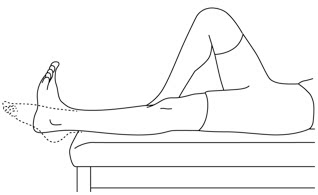
Ankle Exercise 2:
1. Sit with your knees bent and your feet flat on the floor.
2. Slide your heel back as far as you can, keeping your heel down. You may feel pressure at the front of the ankle. Hold for several seconds, then relax. Repeat.
Goal: Try to slide the heel back a little bit farther each time. Practice until full motion is restored. Compare to other ankle or baseline.
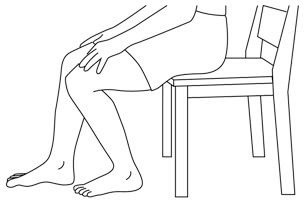
Elbow Exercise 1:
1. Sit with your elbow supported.
2. Extend your elbow slowly, letting the weight of your arm assist. Release your arm. Repeat several times.
Goal: Move your arm farther with each repetition, but do not force the movement.
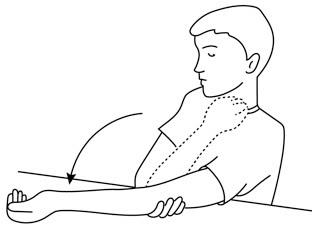
Elbow Exercise 2:
Do not attempt this exercise if you have swelling or pain in your elbow.
1. Sit with your elbow resting near the edge of the table.
2. Straighten your elbow as far as you can, assisting with your other hand.
Goal: Complete extension. Compare with your other arm or baseline.
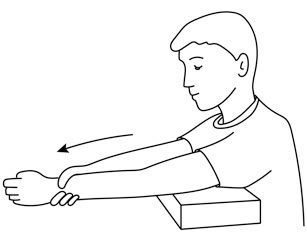
Elbow Exercise 3:
This exercise can be started as soon as bleeding has stopped.
1. Sit with your elbow bent and arm supported.
2. Turn your palm up, then down. Repeat several times.
Goal: Turn palm without moving the rest of your arm. Turn your palm upward a little more each time, but do not force the movement.
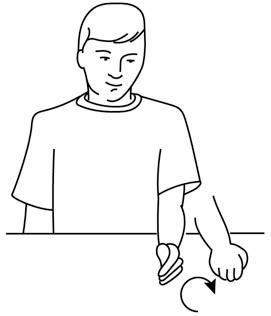
Knee Exercise 1:
This exercise can be started as soon as bleeding has stopped.
1. Sit with your legs out straight or lie on your back.
2. Bend your hip and knee, and slide your heel toward your body. Then straighten your knee by sliding your heel away from your body. Repeat several times until your leg feels tired.
Goal: Try to get the back of the knee as close to the surface as possible. Try to bend your knee as much as it could bend before the bleed.
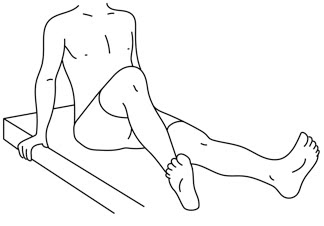
Knee Exercise 2:
1. Sit in a chair. Support the weight of the affected leg with the other leg, if necessary.
2. Allow your knee to bend as much as is comfortable, then straighten your leg as far as you can.
Goal: Try to bend a bit more each time.
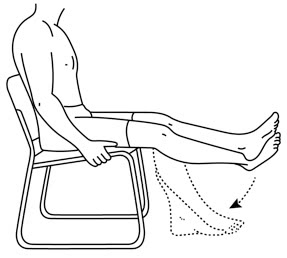
Knee Exercise 3:
Note: If you have difficulty lying on your stomach, it may be necessary to place a pillow under your waist so your hip is more comfortable or a pad under your thigh to take pressure off your knee cap.
1. Lie on your stomach.
2. Bend your knee and try to touch your heel to your buttock. Assist with your other leg, if necessary. Then straighten your leg as far as you can.
Goal: Bend your knee as much as it could bend before the bleed.
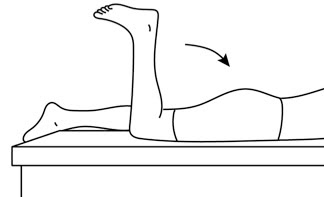
This material was originally published by the World Federation of Hemophilia (WFH) in Exercises for People with Hemophilia and has been adapted and reprinted with permission. The WFH is not responsible for any inaccuracies in content different from the content of the original English edition. © 2006 World Federation of Hemophilia. Illustrations copyright of VHI, 1999. For a complete list of exercises, visit wfh.org
Moving through life.
Learn how to transition through various stages of life with hemophilia, from self-infusing to going to college.
Building community.
Get tips on building a strong support system—an important component of living with hemophilia.
Moving through life.
Learn how to transition through various stages of life with hemophilia, from self-infusing to going to college.
Building community.
Get tips on building a strong support system—an important component of living with hemophilia.
